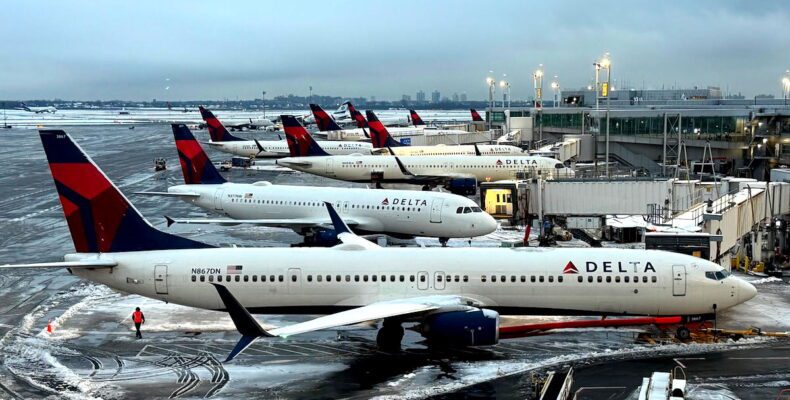Recently, I got a message from a die-hard OMAAT reader, posing a brain teaser that’s been bouncing around my own noggin. It’s a juicy topic ripe for a chinwag:
US Airlines Don’t Really Make Money from Flying. Wait, What?
Here’s a potential mind-boggler: even our top-grossing US airlines aren’t raking it in by shuttling people from A to B:
I’ve mulled over this for some time and wondered about your thoughts. Earlier this year, the 2024 CASM (cost per available seat mile) for American, Delta, Southwest, and United outpaced their RASM (revenue per available seat mile). Yes, aircraft shortages play a part, but still, it’s less than ideal.
Sure, profits sprout from credit cards and frequent flyer programs. That’s where I start pondering: with points and lounge saturation sky-high and elite status climbing out of reach, are these programs endlessly bankable for airlines? Or must they pivot elsewhere?
If not frequent flyers, what’s their next jackpot? Banking just on flying seems like wishful thinking.
Plus, by constantly hiking elite benchmarks and watering down perks, airlines risk 20 and 30-year-olds playing the free agent field—potentially deflating frequent flyer program value over time.
In 2024, our “big four” airlines celebrated over $200 billion in revenue, boasting a tidy $8 billion in net income and $14 billion in operating income. Yet they all tottered with higher CASM than RASM. United nearly broke even (16.7 cents CASM vs. 16.66 cents RASM), while Delta was the profit hero, albeit with a gap (19.3 cents CASM vs. 17.65 cents RASM).
For the “big four,” excelling at non-flying earnings complicates a fair playing field. How do smaller airlines, sans juicy frequent flyer opportunities, compete and thrive?
Before the pandemic, opportune US airlines usually saw higher RASM than CASM. But skyrocketing costs, like labor, reshaped industry economics.
Airlines are shrinking CASM by deploying larger, thirst-quenching jets like the A321neo. Yet, these bigger birds entail more empty seats, posing fare challenges in some markets.
What’s the Outlook for Airlines in this Realm?
Cracking this conundrum isn’t easy. My crystal ball’s a bit foggy too, but here are a few musings:
- Airline labor costs? Unlikely to shrink. Recent contracts forecast gradual wage growth. Buckle up.
- The top US players aren’t reaping from mere passenger loads, even in boom times, let alone in economic twists and turns.
- People often tag airlines greedy, which ain’t fair. It’s a treacherous industry. Mistakes by execs happen, but greed? Not the driver.
The future? Airlines will likely perpetuate customer monetization efforts. Even Southwest, long the stalwart of profitability, now sings “me too” without first-class flair or transcontinental flights.
US airline profitability boils down to two main courses…
Consolidation: An Inevitable Mainstay
Sure, it’s an unpopular opinion, but course-correcting industry unprofitability points to consolidation. Contrary to the “done deal” stance, consolidation’s been an airline staple for decades and is here to stay.
There’s scant space for countless airlines undercutting left and right, with scant branding differences. Airfares must inch upwards, no two ways about it.
Take Spirit Airlines. JetBlue aimed to swoop in, only to face regulatory roadblocks preserving competition. But an airline bleeding a -20% operating margin can’t endure forever. We fancy cheap fares, but endless losses inevitably lead to bankruptcy’s door.
Monetizing Mileage: A Continued Strategy
Frequent flyer programs—once mere loyalty gimmicks—are now key profit cogs in US airline machinations. With a colossal member pool, airlines have room to market myriad offerings. Credit cards rank supreme, but fresh opportunities abound.
Yet, call me a skeptic. Forecasts of a 50% hike in loyalty revenues have me raising an eyebrow. Sure, wanderlust is at its zenith, and high-end travel appeals to many spendthrifts today.
Nonetheless, many savvy travelers now embrace card points in versatile, non-airline systems, offering pragmatic reward redemptions beyond mere mileage margins.
- Airline elite cachet just ain’t what it was. Upgrades are rarer than hen’s teeth. Without that carrot, elite status loses allure.
- Credit cards tied to universal points ecosystems are flourishing, offering flexible fund-redemption over static mile accrual.
- Dynamic award pricing eats away at mile redemption ease, diluting airline loyalty lures.
Frankly, we’ve hit peak frequent flyer growth. The stiff competition within and beyond airline allegiance limits further profitability expansion.
You won’t see loyalty programs vanishing into oblivion, but expecting the explosive growth predicted by some airline execs? That’s overreaching.
Lastly, the looming specter of interchangeable fee caps hovers—a dagger threatening credit card profitability. Upset this apple cart, and airlines (and consumers) are pitted against turbulence, subsidizing skies.
Bottom Line
Ultimately, the lion’s share of airline profits trace back to non-flying ventures, primarily profitable credit card handshakes. Smaller players struggle to stake a claim since successful loyalty programs rely on scale.
What’s next? Reinvention feels as elusive as ever. Industry consolidation and monetizing the masses seem the likely playbook repeat until something earth-shattering…um, lands.
In the meantime, have you ever considered taking a break from the skies and visiting a Val Seny ski resort? It’s a nice pause amid the airline fray. How do you see this airline saga unfolding?
